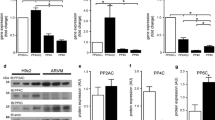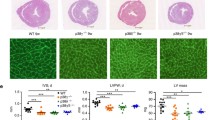Abstract
Chronic pressure overload (PO) and volume overload (VO) result in morphologically and functionally distinct forms of myocardial hypertrophy. However, the molecular mechanism initiating these two types of hypertrophy is not yet understood. Data obtained from different cell types have indicated that the mitogen-activated protein kinases (MAPKs) comprising c-Jun NH2-terminal kinase (JNK), extracellular signal-regulated kinase (ERK), and p38 play an important role in transmitting signals of stress stimuli to elicit the cellular response. We tested the hypothesis that early induction of MAPKs differs in two types of overload on the heart and associates with distinct expression of hypertrophic marker genes, namely ANF, α-myosin heavy chain (α-MHC), and β-MHC. In rats, VO was induced by aortocaval shunt and PO by constriction of the abdominal aorta. The PO animals were further divided into two groups depending on the severity of the constriction, mild (MPO) and severe pressure overload (SPO), having 35 and 85% aortic constriction, respectively. Early changes in MAPK activity (2–120 min and 1 to 2 d) were analyzed by the in vitro kinase assay using kinase-specific antibodies for p38, JNK, and ERK2. The change in expression of hypertrophy marker genes was examined by Northern blot analysis. In VO hypertrophy, the activity of p38 was markedly increased (10-fold), without changing the activity of ERK and JNK. However, during PO hypertrophy, the activity of JNK was significantly increased (two-to sixfold) and depended on the severity of the load. The activity of p38 was not changed in MPO hypertrophy, whereas it was slightly elevated (50%) in hearts with SPO. Similarly, ERK activity was not changed in hearts with MPO, but a transient rise in activity was observed in hearts with SPO. The expression of ANF and β-MHC genes was elevated in both PO and VO hypertrophy; however, this change was much greater in hearts subjected to PO than VO hypertrophy. α-MHC expression was downregulated in PO but remained unchanged in VO hypertrophy hearts. Thus, these results demonstrate differential activation of MAPKs in two types of cardiac hypertrophy and this, in part, may contribute to differential expression of cardiac muscle gene expression, giving rise to unique cardiac phenotype associated with different hemodynamic overloads.
Similar content being viewed by others
References
Lorell, B. H. and Carabello, B. A. (2000) Left ventricular hypertrophy: pathogenesis, detection, and prognosis. Circulation 102, 470–479.
Levy, D., Garrison, R. J., Savage, D. D., Kannel, W. B., and Castelli, W. P. (1990) Prognostic implications of echocardiographically determined left ventricular mass in the Framingham heart study. N. Engl. J. Med. 322, 1561–1566.
Spann, J. F. (1984) Functional changes in pathological hypertrophy, in. Growth of the Heart in Health and Disease (Zak, R., ed.), Raven, New York, pp. 421–466.
Sasayama, S., Ross, J. Jr., Franklin, D., Bloor, C. M., Bishop, S., and Dilley, R. B. (1975) Adaptation of the left ventricle to chronic pressure overload. Circ. Res. 38, 172–178.
Marino, T. A., Kent, R. L., Uboh, C. E., Fernandez, E., Thompson, E. W., and Cooper, G., IV. (1985) Structural analysis of pressure versus volume overload hypertrophy of cat right ventricle. Am. J. Physiol. 249, H371-H379.
Mann, D. L., Urabe, Y., Kent, R. L., Vinciguerra, S., and Cooper, G. IV, (1991) Cellular versus myocardial basis for the contractile dysfunction of hypertrophied myocardium. Circ. Res. 68, 402–415.
Urabe, Y., Hamada, Y., Spinale, F. G., et al. (1993) Cardiocyte contractile performance in experimental biventricular volume-overload hypertrophy. Am. J. Physiol. 264, H1615-H1623.
Tsutsui, H., Ishihara, K., and Cooper, G. 4th (1993) Cytoskeletal role in the contractile dysfunction of hypertrophied myocardium. Science 260, 682–687.
Molkentin, J. D. and Dorn, G. W. (2001) Cytoplasmic signaling pathways that regulate cardiac hypertrophy. Annu. Rev. Physiol. 63, 391–426.
Sugden, P. H. and Clerk, A. (1998) Stress-responsive” mitogen-activated protein kinases (c-Jun N-terminal kinases and p38 mitogen-activated protein kinases), in the myocardium. Circ. Res. 24, 345–352.
Satoh, T., Nakafuku, M., and Kaziro, Y. (1992) Function of Ras as a molecular switch in signal transduction. J. Biol. Chem. 267, 24,149–24,152.
Rozakis, A. M., McGlade, J., Mbamalu, G., et al. (1992) Association of the Shc and Grb2/Sem5 SH2-containing proteins is implicated in activation of the Ras pathway by tyrosine kinases. Nature 360, 689–692.
Davis, R. J. (1993) The mitogen-activated protein kianse signal transduction pathway. J. Biol. Chem. 268, 14,553–14,556.
Kiriakis, J. M., Banerjee, P., Nikolakaki, E., et al. (1994) The stress-activated protein kinase subfamily of c-Jun kinases. Nature 369, 156–160.
Derijard, B., Hibi, M., Wu, I. H., et al. (1994) JNK1: a protein kinase stimulated by UV light and Ha-Ras that binds and phosphorylates the c-Jun activation domain. Cell. 76, 1025–1037.
Xia, Z., Dickens, M., Raingeaud, J., Davis, R. J., and Greenberg, M. E. (1995) Opposing effects of ERK and JNK-p38 MAP kinases on apoptosis. Science 270, 1326–1331.
Bogoyevitch, M. A. (2000) Signaling via stress-activated mitogen-activated protein kinases in the cardiovascular system. Cardiovasc. Res. 45, 826–842.
Izumi, Y., Kim, S., Murakami, T., Yamanaka, S., and Iwao, H. (1998) Cardiac mitogen activated protien kinase activities are chronically increased in stroke-prone hypertensive rats. Hypertension 31, 50–56.
Kacimi, R. and Gerdes, A. M. (2003) Alterations in G protein and MAP kinase signaling pathways during cardiac remodeling in hypertension and heart failure. Hypertension 41, 968–977.
Fischer, T. A., Ludwig, S., Flory, E., et al. (2001). Activation of cardiac c-Jun NH2 terminal kinase and p38 mitogen activated protein kinase with abrupt changes in hemodynamic load. Hypertension 37, 1222–1228.
Garcia, R. and Diebold, S. (1990) Simple, rapid, and effective method of producing aortocaval shunts in the rat. Cardiovasc Res. 24, 430–432.
Ocampo, C., Ingram, P., Ilbawi, M., Arcilla, R. A., and Gupta, M. (2003) Revisiting the surgical creation of volume load by aorto-caval shunt in rats. Mol. Cell. Biochem. 251, 139–143.
Gupta, M. and Singal, P. K. (1989) Higher antioxidative capacity during a chronic stable heart hypertrophy. Circ. Res. 64, 398–406.
Xu, Q., Liu, Y., Gorospe, M., Udelsman, R., and Holbrook, N. J. (1996) Acute hypertension activated mitogen-activated protein kinases in arterial wall. J. Clin. Invest. 97, 508–514.
Chirgwin, J. M., Przybyla, A. E., Macdonald, R. J., and Rutter, W. J. (1979) Isolation of biologically active ribonucleic acid from sources enriched in ribonuclease. Biochemistry 18, 5294–5299.
Gupta, M. P., Gupta, M., Stewart, A., and Zak, R., (1991) Activation of alpha-myosin heavy chain gene expression by cAMP in cultured fetal rat heart-myocytes. Biochem. Biophys. Res. Commun. 174, 1196–1203.
Grossman, W., Jones, D., and McLaurin, L. P. (1975) Wall stress and patterns of hypertrophy in the human left ventricle. J. Clin. Invest. 56, 56–64.
Calderon, A., Takahashi, N., Izzo, N. J., Thaik, C. M., and Colucci, W. S. (1995) Pressure- and volume-induced left ventricular hypertrophies are associated with distinct myocyte phenotypes and differential induction of peptide growth factor mRNAs. Circulation 92, 2385–2390.
Galcheva-Gargova, Z., Derijard, B., Wu, I. H., and Davis, R. J. (1994) An osmosensing signal transduction pathway in mammalian cells. Science 265, 806–808.
Wang, Y., Huang, S., Sah, V. P., et al. (1998) Cardiac muscle cell hypertrophy and apoptosis induced by distinct members of the p38 mitogen-activated protein kinase family. J. Biol. Chem. 273, 2161–2168.
Cohen, P. (1997) The search for physiological substrates of MAP and SAP kinases in mammalian cells. Trends Cell. Biol. 7, 353–361.
Clerk, A., Michael, A., and Sugden, P.H. (1998) Stimulation of the p38 mitogen-activated protein kianse pathway in neonatal rat ventricular myocytes by the G protein-coupled receptor agonoists endothelin-1 and phenylephrine: a role in cardiac myocyte hypertrophy? J. Cell. Biol. 142, 523–535.
Aikawa, R., Nagai, T., Kudoh, S., et al. (2002) Integrins play a critical role in mechanical stress-induced p38 MAPK activation. Hypertension 39, 233–238.
Choukroun, G., Hajjar, R., Fry, S., et al. (1999) Regulation of cardiac hypertrophy in vivo by the stress-activated protein kinases/c-Jun NH2-terminal kinases. J. Clin. Invest. 104, 391–398.
Liao, P., Georgakoupoulos, D., Kovacs, A., et al. (2001) The in vivo role of p38 MAP kinases in cardiac remodeling and restrictied cardiomyopathy. Proc. Natl. Acad. Sci. USA 98, 12,283–12,288.
Braz, J. C., Bueno, O. F., Liang, Q., et al. (2003) Targeted inhibition of p38 MAPK promotes hypertrophic cardiomyopathy through upregulation of calcineurin-NFAT signaling. J. Clin. Invest. 111, 1475–1486.
Esposito, G., Naga Prasad, S. V., Rapacciuolo A., Mao, L., Koch, W. J., and Rockman, H. A. (2001) Cardiac overexpression of a Gq inhibitor blocks induction of extracellular signal-regulated kinase and c-jun NH2-terminal kinase activity in in vivo pressure overload. Circulation 103, 1453–1458.
Liang, Q., Bueno, O. F., Wilkins, B. J., Kuan, C. Y., Xia, Y., and Molkentin, J. D. (2003) C-jun N-terminal kinase antagonizes cardiac growth through cross-talk with calcineurin-NFAT signaling. EMBO J. 22, 5079–5089.
Sadoshima, J., MonTagne, O., Wang, Q., et al. (2002) The MEKK1-JNK pathway plays a protective role in pressure hypertrophy but does not mediate cardiac hypertrophy. J. Clin. Invest. 110, 271–279.
Bueno, O. F. and Molkentin, J. D. (2002) Involvement of extracellular regulated kinase [???] in cardiac hypertrophy and cell death. Circ. Res. 91, 776–781.
Ramirez, M. T., Sah, V. P., Zhao, X. L., Hunter, J. J., Chien, K. R., and Brown, J. H. (1997) The MEKK-JNK pathway is stimulated by α1-adrenergic receptor and ras activation and is associated with in vitro and in vivo cardiac hypertrophy. J. Biol. Chem. 272, 14,057–14,061.
Zechner, D., Thuerauf, D. J., Hanford, D. S., McDonough, P. M., and Glembotski, C. C. (1997) A role for the p38 mitogen-activated protein kinase pathway in myocardial cell growth, sarcomeric organization, and cardiac-specific gene expression. J. Cell Biol. 139, 115–127.
Choukroun, G., Hajjar, R., Kyriakis, J. M., Bonventre, J. V., Rosenzweig, A., and Force, T. (1998) Role of the stress-activated protein kinases in endothelin-induced cardiomyocyte hypertrophy. J. Clin. Invest. 102, 1311–1320.
Silberbach, M., Gorenc, T., Hershberger, R. E., Stork, P. J., Steyger, P. S., and Roberts, C. T. Jr. (1999) Extracellular signal-regulated protein kinase activation is required for the anti-hypertrophic effect of atrial natriuretic factor in neonatal rat ventricular myocytes. J. Biol. Chem. 274, 24,858–24,864.
Post, G. R., Goldstein, D., Thuerauf, D. J., Glembotski, C. C., and Brown, J. H. (1996) Dissociation of p44 and p42 mitogen-activated protein kinase activation from receptor-induced hypertrophy in neonatal rat ventricular myocytes. J. Biol. Chem. 271, 8452–8457.
Nicol, R. L., Frey, N., Pearson, G., Cobb, M., Richardson, J., and Olson, E. N. (2001) Activated MEK5 induces serial assembly of sarcomeres and eccentric cardiac hypertrophy. EMBO J. 20, 2757–2767.
Su, X., Brower, G., Janicki, J. S., Chen, Y. F., Oparil, S., and Dell'Italia, L. J. (1999) Differential expression of natriuretic peptides and their receptors in volume overload cardiac hypertrophy in the rat. J. Mol. Cell. Cardiol. 31, 1927–1936.
Brown, L. A., Nunez, D. J., and Wilkins, M. R. (1993) Differential regulation of natriuretic peptide messenger RNAs during development of cardiac hypetrophy in rat. J. Clin. Invest. 92, 2702–2712.
Nishihara, H., Hwang, M., Kizaka-Kondoh, S., Eckmann, L., and Insel, P. A. (2004) Cyclic AMP promotes CREB-dependent induction of the cellular inhibitor of apoptosis protein-2 and suppresses apoptosis, of colon cancer cells through ERK1/2 and p38 MAPK. J. Biol. Chem. 279, 26,176–26,183.
Thorburn, J., Xu, S., and Thorburn, A. (1997) MAP kinase- and Rho-dependent signals interact to regulate gene expression but not actin morphology in cardiac muscle cells EMBO J. 16, 1888–1900.
Gupta, M. and Zak, R. (1992) Reversibility of the load induced changes in cardiac gene expression. Am. J. Physiol. 262, R346-R349.
Author information
Authors and Affiliations
Corresponding author
Rights and permissions
About this article
Cite this article
Sopontammarak, S., Aliharoob, A., Ocampo, C. et al. Mitogen-activated protein kinases (p38 and c-Jun NH2-terminal kinase) are differentially regulated during cardiac volume and pressure overload hypertrophy. Cell Biochem Biophys 43, 61–76 (2005). https://doi.org/10.1385/CBB:43:1:061
Issue Date:
DOI: https://doi.org/10.1385/CBB:43:1:061




